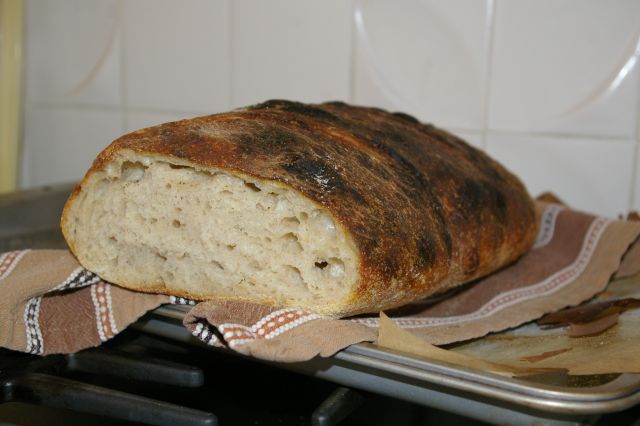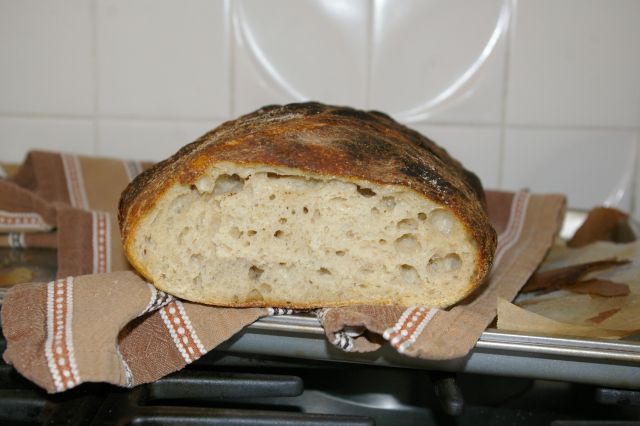My 3+ month old starter doesn't seem to rise much lately. It does a little when it's left out, but it doesn't seem to at all in the fridge. My breads are rising fine and taste sour or not depending on how I treat them, but I wonder if the starter is as healthy as it should be.
When it is on the counter I feed it twice a day as it gets very foamy, fluffy and rises a bit and falls. In the fridge, I feed it about every three days or so, although sometimes sooner because it develops hooch.
I feed it flour equal in volume to the starter but with a bit less water to make a fairly thick batter. Mostly I feed it KA AP, but sometimes add a bit of organic whole grain rye.
Since it seems to work well, I've assumed things are fine, but then I realized I could be wearing it down or something without knowing it and I'd be sunk.
I guess the short question to this long post is- If a starter doesn't rise after a feeding is it still healthy?
Thanks,
Marni
Sounds like it is starving to death and waddling in its own excrements. (Yuck) Try keeping just a scant tablespoon of ripe starter, add a 1/4 cup of water and stir, stir, stir, stir, then run it through a fine sieve. Now take that water and add flour to it to your favorite consistancy. Mark and leave it out to rise and watch it. After it peaks, Repeat, but with only 1 1/2 teaspoons ripe starter, don't forget to sieve. You might end up refreshing it twice or 3 times a day. Give it more flour if you want more time between feeds.
If you want to refrigerate it for longer periods of time, don't let it ripen on the counter top first, pop it into the fridge within an hour after feeding. A ripe starter placed into the fridge should be used within 24 hours.
Mini O
David
I appreciate you both answering my question. It does seem though like two different opinions. So, I think since I know hooch means I have a hungry starter and I am putting it directly into the fridge, I will try feeding it more.
I fed it four hours ago with a mix of AP and rye. It did not grow much, but became fluffy and foamy on top. It will probably start to sink in the middle in about one hour. This sounds like David's description since it is a liquid starter.
Mini, I can try your suggestion, but I don't know what the goal of it is. Is it a way to refresh a starter or rescue one? I don't think this one is dying. Sorry if I don't get it.
Thanks for any more thoughts you have.
Marni
David
than I had imagined. True, If you starter is very thin and runny or your flour is low or no gluten, there will be no rise, however there will be foam and fine bubbles like you discribe. You will have to feed it more often though, just to make sure it stays healthly. David and I don't disagree. I keep my starters well fed and haven't seen hootch in a long time.
"Is it a way to refresh a starter or rescue one?"
Both. The theory behind the sieve is to filter out old gluten strands, old used up flour particles or large waste particles from the flour,yeast & bacteria. The beasties will just slide through the sieve and the old bits get caught. The beasties then have lots of fresh room to bud and multiply after they receive fresh flour. After a few days in the fridge, and esp. with hootch, there are lots of waste products inside the starter. Sieving it, clears the starter or "washes" it as Mariana explained. I took up her suggestion and I like what I smell and taste.
Forgive me if I confused you, I thought you had noticed a rapid decline in your starter and that it used to rise more. Oh, and, please, questions are always welcome... someone will know the answer or have more suggestions. :)
Mini O
I made a basic loaf yesterday to see how the starter is doing. I have to admit that I didn't follow any sort of recipe. I had refreshed the starter and it was peaking so put about 2 cups of it in the mixer with flour and some water to make a thick batter. Let it sit 30 minutes, added a splash of olive oil (my family keeps asking for soft bread) and more flour and salt. It rose for 4-5 hours with one stretch and fold. I shaped it (badly) and let it have another 1 1/2 hours. Now it ws 12:30 am so I needed to bake it.
It did not rise to double in the bulk rise, but definitely grew quite a bit. The dough was very slack. Maybe one of my mistakes is making it too wet. That and the fact that I did no measuring! After shaping the rise was minimal, but it didn't get much time. It rose a lot in the oven and looks fine, I think .
.
here's a second view
I haven't tasted it yet, but I have to admit that my husband cut it just 15 minutes out of the oven and enjoyed it. He's been educated about waiting, but insists he likes it warm from the oven. Well, I am baking for his enjoyment too. Besides he's the one who knows how to post pics.
Again, thanks for your thoughts.
Marni
David
MiniO and David, I've been feeding my starter like crazy and it is rising in response. It had risen like this when it was new and I thought the decrease was because it was in the fridge. It seemed to be baking fine, but something just seemed off. (Go with your intuition!) I've had it on the counter for the past three days, feeding it at least twice a day.
MiniO, I did try the sieving, but I don't have a proper sieve. I tried two variations, one died and the other I fed lots of rye and it is tying to escape the bowl. Rye is wonderful. It's what made my starter with in the first place.
So now I need to (get to) go bake - can't let good starter going to waste!
Another question - Does starter rise less in the fridge?
Thanks so much,
Marni
"Does starter rise less in the fridge? "
It absolutely does. In fact, I just switched to a feeding schedule that involves me doing a 1:2:2 feed followed by immediate refrigeration, and after that there was no rise whatsoever (I have a fairly cold fridge). Three days later, I pulled it out, gave it 8 hours to warm up and feed (at which point it doubled and fell), then did another 1:2:2 feed at room temperature, and it's very much alive and active once more and ready to be used.
But the real key here, and this echos dmsnyder's comments, is to make sure that, if you refrigerate your starter for more than a day or two, you give it a couple feedings at room temperature before baking with it.